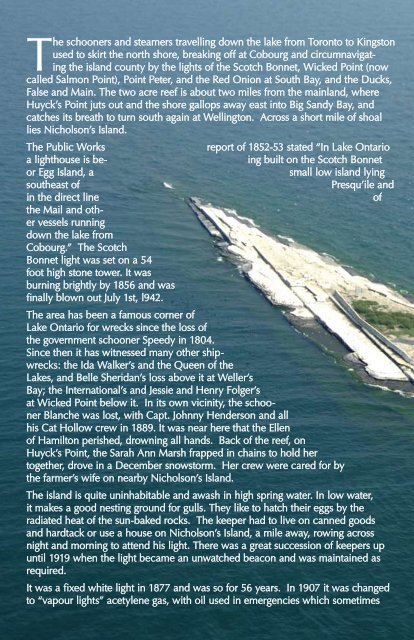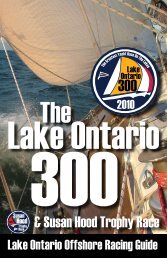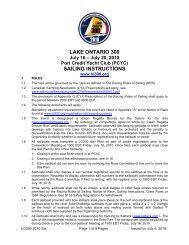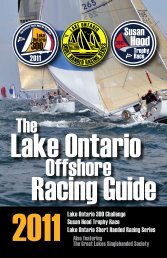LO300 Booklet 2010_04_09 Low RES - Lake Ontario 300
LO300 Booklet 2010_04_09 Low RES - Lake Ontario 300
LO300 Booklet 2010_04_09 Low RES - Lake Ontario 300
- No tags were found...
Create successful ePaper yourself
Turn your PDF publications into a flip-book with our unique Google optimized e-Paper software.
Page 20<strong>LO<strong>300</strong></strong>The schooners and steamers travelling down the lake from Toronto to Kingstonused to skirt the north shore, breaking off at Cobourg and circumnavigatingthe island county by the lights of the Scotch Bonnet, Wicked Point (nowcalled Salmon Point), Point Peter, and the Red Onion at South Bay, and the Ducks,False and Main. The two acre reef is about two miles from the mainland, whereHuyck’s Point juts out and the shore gallops away east into Big Sandy Bay, andcatches its breath to turn south again at Wellington. Across a short mile of shoallies Nicholson’s Island.The Public Worksa lighthouse is beorEgg Island, asoutheast ofin the direct linethe Mail and othervessels runningdown the lake fromCobourg.” The ScotchBonnet light was set on a 54foot high stone tower. It wasburning brightly by 1856 and wasfinally blown out July 1st, l942.report of 1852-53 stated “In <strong>Lake</strong> <strong>Ontario</strong>ing built on the Scotch Bonnetsmall low island lyingPresqu’ile andofThe area has been a famous corner of<strong>Lake</strong> <strong>Ontario</strong> for wrecks since the loss ofthe government schooner Speedy in 18<strong>04</strong>.Since then it has witnessed many other shipwrecks:the Ida Walker’s and the Queen of the<strong>Lake</strong>s, and Belle Sheridan’s loss above it at Weller’sBay; the International’s and Jessie and Henry Folger’sat Wicked Point below it. In its own vicinity, the schoonerBlanche was lost, with Capt. Johnny Henderson and allhis Cat Hollow crew in 1889. It was near here that the Ellenof Hamilton perished, drowning all hands. Back of the reef, onHuyck’s Point, the Sarah Ann Marsh frapped in chains to hold hertogether, drove in a December snowstorm. Her crew were cared for bythe farmer’s wife on nearby Nicholson’s Island.The island is quite uninhabitable and awash in high spring water. In low water,it makes a good nesting ground for gulls. They like to hatch their eggs by theradiated heat of the sun-baked rocks. The keeper had to live on canned goodsand hardtack or use a house on Nicholson’s Island, a mile away, rowing acrossnight and morning to attend his light. There was a great succession of keepers upuntil 1919 when the light became an unwatched beacon and was maintained asrequired.It was a fixed white light in 1877 and was so for 56 years. In 1907 it was changedto “vapour lights” acetylene gas, with oil used in emergencies which sometimes<strong>LO<strong>300</strong></strong> <strong>Booklet</strong> <strong>2010</strong>_03_12 FINAL.indd 20<strong>09</strong>/<strong>04</strong>/<strong>2010</strong> 9:08:47 PM










